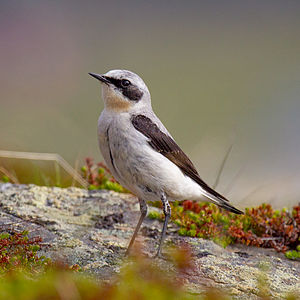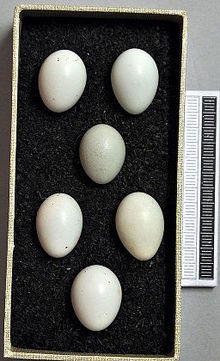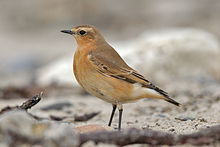Wheatear (species)
| Wheatear | ||||||||||||
|---|---|---|---|---|---|---|---|---|---|---|---|---|

Wheatear ( Oenanthe oenanthe ) |
||||||||||||
| Systematics | ||||||||||||
|
||||||||||||
| Scientific name | ||||||||||||
| Oenanthe oenanthe | ||||||||||||
| ( Linnaeus , 1758) |
The wheatear ( Oenanthe oenanthe ) is a bird art from the family of Fliegenschnäpperartigen (Muscicapidae).
description
The wheatear is 14.5 to 15.5 cm long and weighs between 22 and 28 g. The wingspan is between 26 and 32 cm. The males have in breeding plumage in the spring and summer, so a gray crown and gray back, a black eye stripe that up on the cheeks stretches and widens there something he acts like a mask. There is a white stripe above the black eye stripe. The breast is ocher, the belly white, the wings black. The females are similarly colored, just a little less contrasting because the black mask on the face is not as pronounced and the wings are more brown than black. The birds are very easy to recognize in flight by their characteristic black and white tail color: the white tail / rump has a black T-pattern at the tip. In the plain dress , the sexes are more similar, because the males are then somewhat more inconspicuous with a brown back and parting and a less pronounced mask.
Their call is a whistling hiiit , they often sing a chirping and crunching stanza from a rock, slightly elevated.
nutrition
Wheatears mainly eat insects, but also spiders, snails and earthworms. In autumn they also eat berries.
Habitat and bird migration
Wheatears are widespread as breeding birds all over Europe, they are the only species of the genus Steinschmätzer that also occurs in Northern Europe. They occur mainly in the mountains, but also inhabit other landscapes, preferring open, stony terrain. They are rare in Germany. The birds overwinter in Africa.
Outside of Europe, they are found in Canada and Alaska, Greenland and Siberia.
Bird migration of the population in Alaska
The population in Alaska flies over Northern Russia , Asia , the Caspian Sea to East Africa ( Sudan to Kenya ) and back , covering 30,000 km annually. The wheatear, so it could be determined with light and dark locators , flies for hours at a speed of approx. 50 km / h and covers 450 km per night on its long-distance route depending on the wind.
Brood care

The nest is a bowl loosely built between crevices or piles of stones. Five to six eggs are hatched. The incubation period is about 14 days, then the nestlings are fed by both parents for 15 days.
Danger
The wheatear is considered to be threatened with extinction in Germany (Red List Cat. 1). Worldwide the species is considered not endangered because of its large distribution area.
literature
- Franz Bairlein , D. Ryan Norris, Rolf Nagel, Marc Bulte, Christian C. Voigt, James W. Fox, David JT Hussell, Heiko Schmaljohann: Cross-hemisphere migration of a 25 g songbird. In: biology letters. The Royal Society, Received December 15, 2011. Accepted January 24, 2012. Online ISSN 1744-957X ( full text online )
- Uwe Westphal : Weird birds. Encounters with the bittern, goat milker, hoopoe and other native bird species . pala-verlag, Darmstadt 2015, ISBN 978-3-89566-342-0 , pp. 89–92: Der Steinschmätzer .
swell
- Lars Svensson , Peter J. Grant, Killian Mullarney, Dan Zetterström: The new cosmos bird guide. Kosmos, Stuttgart 1999, ISBN 3-440-07720-9 .
- Lars Jonsson : The birds of Europe and the Mediterranean . Franckh-Kosmos, Stuttgart 1992, ISBN 3-440-06357-7 .
- Paul Sterry (Ed.): The Encyclopedia of the European Bird World . Tosa, Vienna 2003. ISBN 3-85492-813-0 .
Web links
- Oenanthe oenanthe in the Red List of Threatened Species of the IUCN 2008. Posted by: BirdLife International, 2008. Accessed January 31 of 2009.
- Videos, photos and sound recordings of Oenanthe oenanthe in the Internet Bird Collection
- Entry at the Swiss Ornithological Institute
- Slideshow by Heiko Schmaljohann on the migration of the wheatear bird (English)
- Age and gender characteristics (PDF; 4.3 MB) by Javier Blasco-Zumeta and Gerd-Michael Heinze (English)
- Wheatear feathers
Individual evidence
- ↑ Rembert Unterstell: "We'll be gone." Fascination with bird migration: Inspired by modern research methods, ornithologists at the Wilhelmshaven Institute for Bird Research study the internal and external mechanisms of annual migration. Your new model is the little wheatear . In: forschung - The magazine of the German Research Foundation , October 4, 2013, pp. 10–13 ( online ).
- ↑ Christoph Grüneberg, Hans-Günther Bauer, Heiko Haupt, Ommo Hüppop, Torsten Ryslavy, Peter Südbeck: Red List of Germany's Breeding Birds , 5 version . In: German Council for Bird Protection (Hrsg.): Reports on bird protection . tape 52 , November 30, 2015.
- ↑ Oenanthe oenanthe. International Union for Conservation of Nature and Natural Resources, accessed February 14, 2016 .


